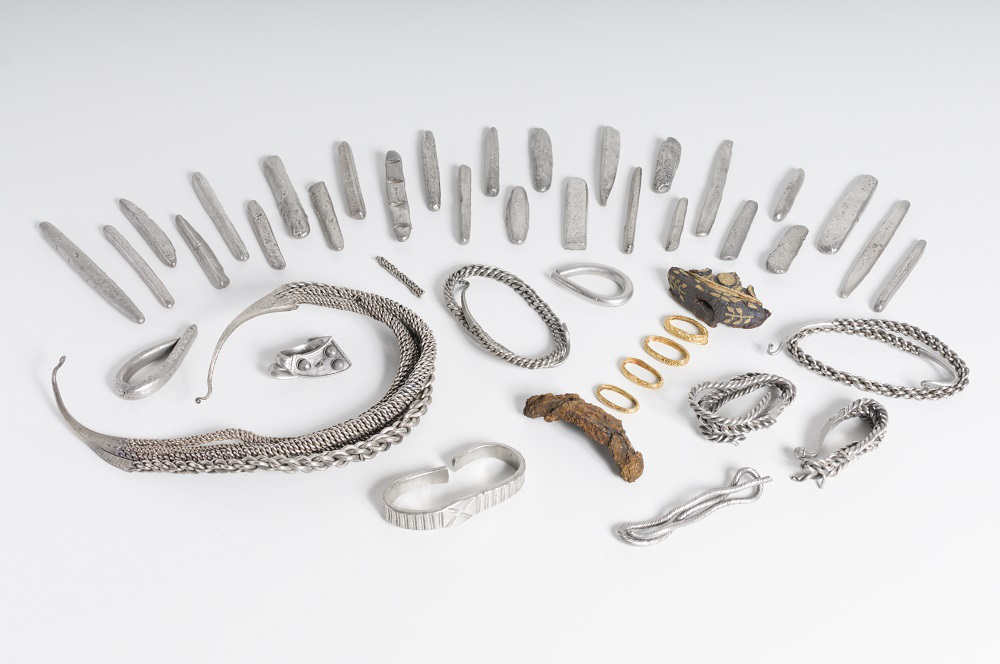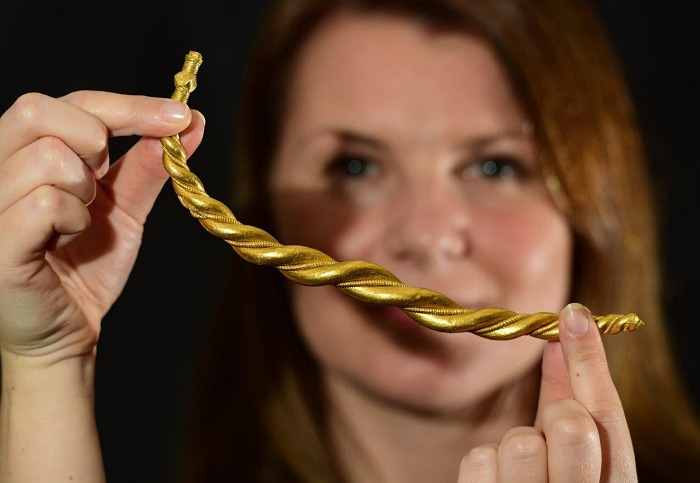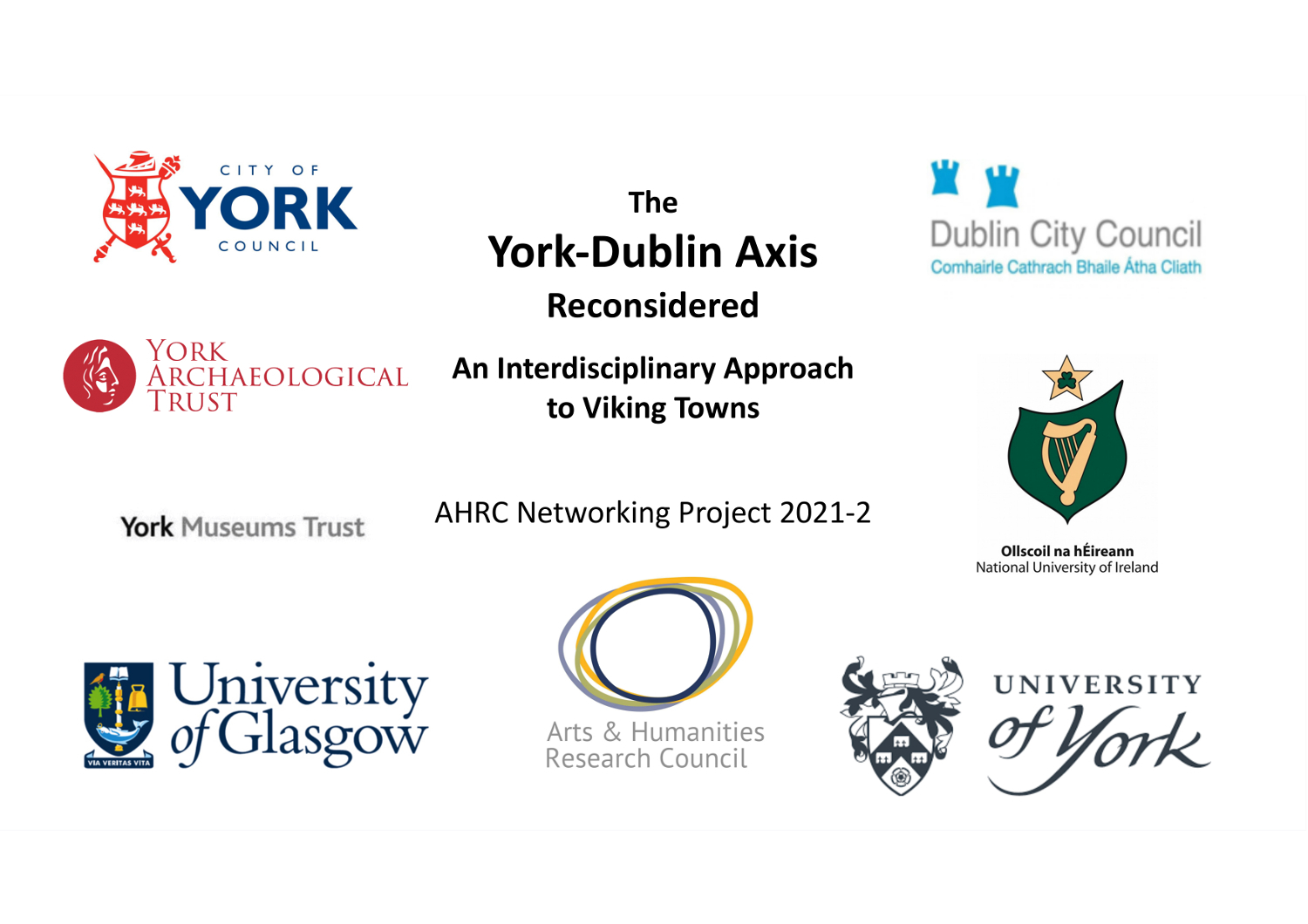24.11.2020

© The Bedale Hoard, Buried circa late 9th to early 10th century AD.
Image courtesy York Museums Trust (Yorkshire Museum)
Click to enlarge image
The York-Dublin Axis Reconsidered:
An Interdisciplinary Approach to Viking Towns
AHRC Networking Project 2021-2
The National University of Ireland is pleased to announce its participation in the York-Dublin Axis Project. This project has recently been awarded funding by Arts and Humanities Research Council (AHRC, part of UK Research and Innovation) under the Research Networking Scheme. This project with the support of Creative Ireland, Dublin City Council, the Universities of Glasgow and York aims to develop new collaborations between York in England and Dublin in Ireland to expand knowledge of their shared Viking-Age history.

© An example of a Viking Gold Arm Ring, AD 866 to 1066.
Photo by Anthony Chappel-Ross
Click to enlarge image.
York and Dublin were two of the most important Viking settlements in Western Europe. Dyflin and Jórvik (Viking-Age Dublin and York) each experienced enormous change during their time as Viking colonial centres in the late ninth and early tenth centuries and were closely linked when the same family ruled over them both. Not only do they have a shared history, but both cities also have comparable waterlogged layers of well-preserved archaeology and have been extensively excavated. Both cities have visitor centres telling the story of their Viking past and are part of the Council of Europe’s Viking Cultural Route. In Dublin, the city’s Viking story is told through Dublinia visitor attraction while in York is it through Jorvik.
Led by Dr Stephen Harrison at the University of Glasgow and Dr Steven Ashby at the University of York, the York-Dublin Axis Project will create and develop new and existing links between archaeologists, historians, academic researchers and heritage practitioners in both cities and elsewhere. The Universities of Glasgow and York are joined by key project partners: Dublin City Council (represented by Dr Ruth Johnson, City Archaeologist), the National University of Ireland (Dr Emer Purcell, historian); City of York Council (Claire MacRae, City Archaeologist); York Archaeological Trust (Dr Chris Tuckley, Head of Interpretation and Engagement) and York Museums Trust (Dr Andrew Woods, Senior Curator).
"Today as modern urban centres, they share challenges in managing their exceptionally
well-preserved and vitally important archaeological deposits, disseminating new research,
and presenting information to the public."
Dr Stephen Harrison
University of Glasgow
We are excited to see how we can help develop an interdisciplinary network of scholars and heritage professionals who share interests in Britain and Ireland’s two greatest Viking towns. Dublin and York are by far the best-documented and best-excavated urban centres in the Viking West and are of exceptional international importance.
Contemporary documentary sources are relatively well studied, and half a century of urban excavations has produced a vast array of evidence. The towns constitute vital resources for archaeologists and heritage professionals alike, but with some important exceptions, communication and collaboration between specialists and practitioners, and between the two modern cities, has been limited’.
"The archaeologies of Viking-Age York and Dublin are exceptional, and of great significance
to the understanding of urbanism not only in Britain and Ireland, but in the Viking world more
generally. The original excavations at Coppergate (York) and Wood Quay (Dublin) were landmark
moments, not only pushing forward our knowledge of the period, but also allowing us to develop new
techniques to understand buildings, objects, landscapes and environments using the extraordinarily
well-preserved evidence that was revealed.
The decades since have seen significant progress in our understanding of the two towns, as new
material continually comes to light. In addition, a battery of new scientific techniques have been developed since the turn of the millennium, that will allow us to better understand this evidence.
The project, then, is timely, and we intend to unite the top specialists in the field to bring the data
together, compare results, and develop a strategy for future work. Our belief is that a focused study
of York and Dublin in-tandem will significantly improve our understanding of both cities, and of their relationship in the Viking past. This can then be used to inform the ways in which their archaeology
and history may be communicated to the public."
Dr Steven Ashby
University of York
This project brings together as wide a range of academics and heritage professionals as possible, with a view to consolidating current research; identifying key areas of future interest and assessing best practice in dissemination and public engagement. This will be done through a series of three workshops to be held in the two cities during 2021-2022. With outreach events to form part established festivals such as the Dublin Festival of History and Jorvik Viking Festival.
"We believe that heritage management and public outreach must be informed by the latest
academic research, and in turn that heritage management and public engagement should influence
research. The connection between Viking Age Dublin and York is one of the greatest stories of the
Viking World, and it deserves to be examined and celebrated. Dublin City Council and the National University of Ireland look forward to working with the UK partners and the international Viking Studies network generated by the project. With Creative Ireland’s support we will have an opportunity to realise the latent public value of these two exceptional Viking towns."
Dr Ruth Johnson
City Archaeologist, Dublin City Council
"The Vikings are hugely popular, and many Dubliners and York citizens are aware and cherish
the Viking history of both towns; however, few are aware that for a time the two were intertwined
under the rulership of the dynasty of Ívarr. This project presents us with the unique opportunity to
re-examine the documentary sources combined with the archaeological evidence from historic and
more recent excavations in both towns to shed light on this early medieval kingdom that stretched
across the Irish Sea. It will also inform our understanding of how the two settlements interacted with
neighbouring Irish and early medieval English kingdoms and will thus provide a comparative model for
urban settlements and political culture in Scandinavia and early medieval Europe."
Dr Emer Purcell
National University of Ireland
Since 2018 the NUI and Dublin City Council have collaborated with partners such as The Norwegian Embassy in Ireland, Dublinia, Destination Viking, Friends of Medieval Dublin, University of Bergen and Museum, Norway, University of Stavanger, Norway, University of Aarhus, Denmark, and the National Museum of Ireland, to promote and reinvigorate Viking studies in Ireland. The flagship event of this collaboration is the annual Dublin Festival of History International Viking Seminar, where scholars from Scandinavia, Great Britain and Ireland present new multidisciplinary research on the Vikings in an accessible format for the wider public. The International Viking Seminar in 2021 and 2022 is timed to coincide with York-Axis project workshops. A key theme will be a comparative history and archaeology of urbanisation in the Viking Age.

« Previous






















